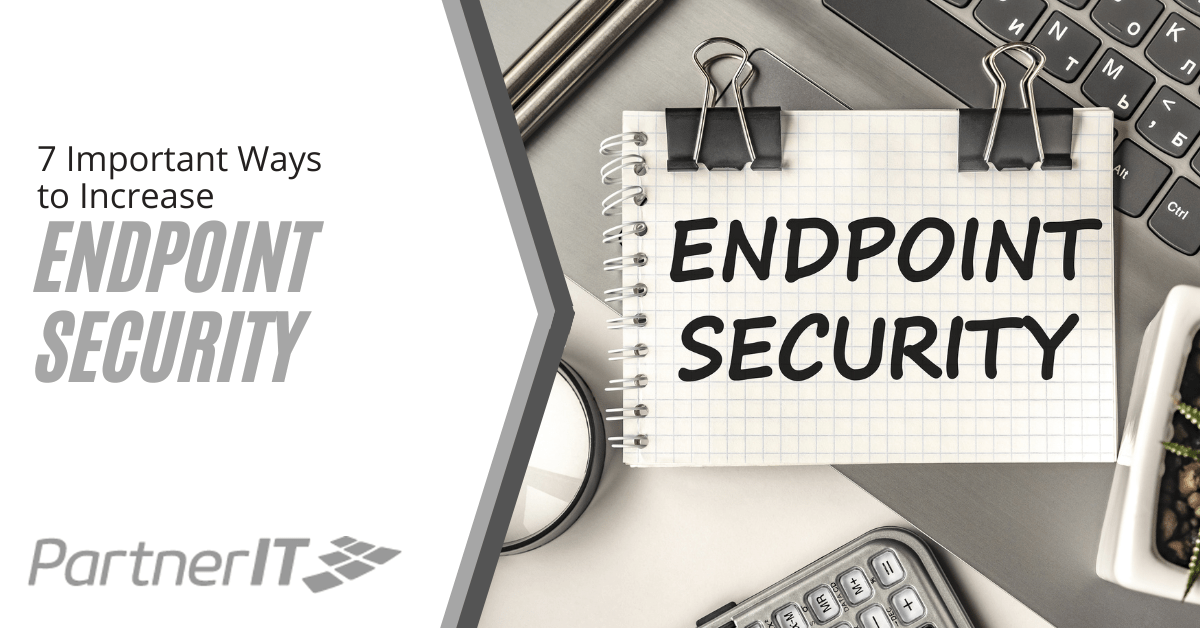Endpoints represent all the various devices connected to your network. The modern workplace will typically have two to three times (or more) the number of endpoints as they have employees.
These network connections include computers, laptops, smartphones, tablets, IoT devices, wireless printers, servers, and more. Each endpoint creates an opportunity for a hacker to gain access to a company’s network and data.
Approximately 68% of organizations have suffered one or more endpoint attacks that compromised data or IT infrastructure. These types of attacks happen due to lax security that allows in malware (81%), as well as due to compromised or stolen devices (28%).
The typical types of attacks experienced through network endpoints are:
- Credential theft
- Phishing
- Account takeover
- General malware
- Denial of Service (DoS)
- Web-based
- Malicious insider
- Compromised/stolen devices
A vital part of any cybersecurity strategy is to ensure all endpoints are properly protected so they can’t be exploited to gain access to your digital assets. Below are several important ways to safeguard endpoints and reduce the risk of a breach.
1. Use Firmware Security to Prevent Infection Before Boot
Firmware attacks have been on an upswing. These types of attacks often target a device outside the normal operating system visibility. They attack at the firmware level, usually before a system can boot.
When choosing hardware, make sure that strong firmware security is included. Firmware protections are often in the hands of the manufacturer since firmware lives outside the operating system. For devices you already own, you should ensure that firmware updates are done regularly. You’ll often need to look for these in a manufacturer’s application on the device.
2. Automate Device Updates
Approximately 60% of Android smartphones are running on an operating system (OS) that is more than two years old. When devices aren’t updated, including the OS, software, and firmware, they are at larger risk for a breach.
Unpatched system vulnerabilities are one of the major enablers of data breaches. The easiest way to keep up with all those device updates throughout the organization is by using managed IT services. We handle all updates for you and ensure that they go through smoothly.
3. Use Data Encryption
Data encryption is more accessible than you may think. It’s not something that takes a lot of time or energy, it’s baked into many processes automatically. Encrypting data keeps it protected from unauthorized access and can boost compliance and cybersecurity
Areas to use encryption for endpoint security:
- Laptop hard drive encryption
- VPNs for mobile devices
- Use of email encryption for sensitive messages and attachments
4. Manage and Monitor Endpoints
As of March 2021, over 30% of all Canadian workers were working remotely from home. Many others enjoy a hybrid schedule where they work part-time in the office and part-time at home. The fact that network endpoints are no longer located in a single place, means that their security needs to be more robust than in the past.
The use of an endpoint device management application (such as Intune in Microsoft 365) is essential to properly manage and monitor all those endpoints. This type of application gives a company visibility into the endpoints connecting to business resources. This includes both company-owned devices and employee-owned devices.
Using an endpoint device manager, you can quickly grant or revoke access to company assets, monitor behavior patterns to detect insider threats, and more.
5. Enforce a Data Use Policy
Do the employees at your company know what corporate data they can and cannot save on their personal devices? Are there any rules in place about downloading apps and software on company devices?
These answers and more should be included in a data use policy. This is a policy that provides rules designed to protect company data and reduce the risk of an endpoint breach.
You should put together a data use policy for your organization and enforce it. This reduces the risk of a missing or stolen device being a major cause of a breach of sensitive information.
6. Secure IoT Devices Properly
The Internet of Things (IoT) is growing rapidly. Companies use smart sensors, wireless printers, smart whiteboards, IP video cameras, and many other types of IoT technology.
Unfortunately, these endpoints are often neglected when it comes to an ongoing cybersecurity strategy. They should be updated regularly, just like computers and other devices. It’s also good to put IoT devices on a separate network from devices that hold important company data. This separation helps reduce the damage from an IoT device breach.
7. Train Employees on Device Security
You can’t expect employees to use best security practices unless you teach them. And not just once. Employee cybersecurity training needs to happen on an ongoing basis.
Train employees on how to properly secure devices, about the dangers of phishing via email and SMS, and other data protection best practices.
Get a Personalized Roadmap to Improve Endpoint Security
PartnerIT can help your Ontario business with a personalized strategy to improve areas of endpoint protection to reduce your risk.
Contact us today to learn more at 519-672-0900 or through our website.



